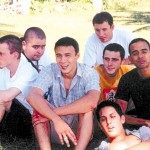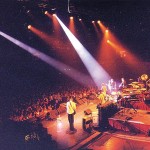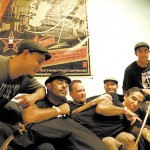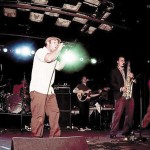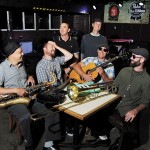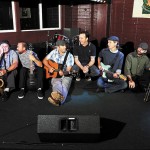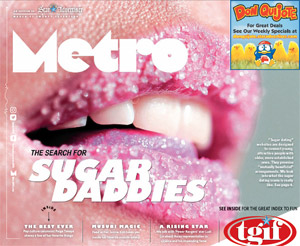Go Jimmy Go
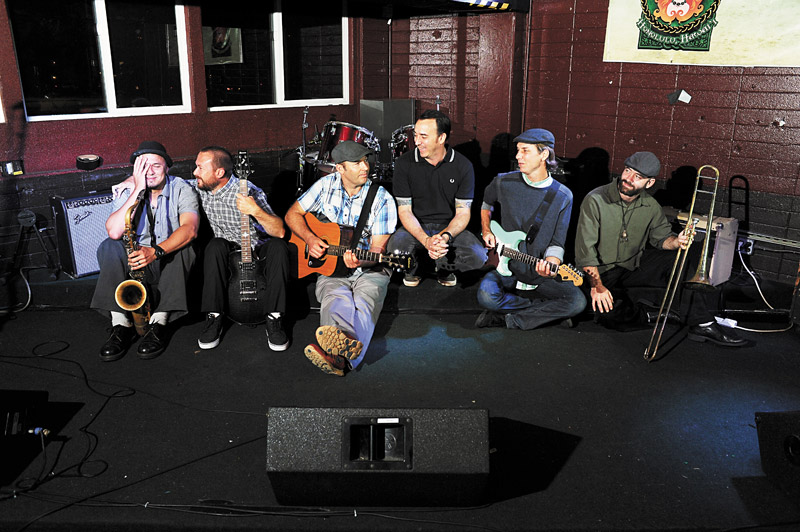
Go Jimmy Go (from left): Eric White, Ian Ashley, Jason “Bison” Friedmann, Shon Gregory, Andrew McClellan and Brandon Hutton
When local ska/rocksteady band Go Jimmy Go gathered at Anna O’Brien’s for the photo shoot for this story, it was the first time that they’d taken a group photo in six years. And just organizing it proved difficult enough for saxophonist Eric White, who acts as the band’s PR liaison. He had to work around all six members’ hectic schedules — which include full-time jobs, gigs with other bands, and families.
“It has been very hard to get together,” White says.
He’s talking about the shoot specifically, but generally, that sentiment is applicable, too. It is, in many ways, indicative of why the band, after 20 years, is dissolving this month. When the core of Go Jimmy Go formed in 1996 (they’ve had a set of rotating members throughout the years), they were in their early 20s. Now, they’re in their early 40s, and life, as it has a way of doing, has gotten busier for each of them as the years have passed.
“Everyone has got different jobs, and now they have jobs and families,” says lead singer Jason “Bison” Friedmann. “You can’t, like in the earlier days, say, ‘let’s quit and go on tour for a few years’ — you can’t quit on your family, and you can’t quit on a business that you’ve built.”
On why they are disbanding now, White sums it up neatly: “We have done everything that we needed to do.”
Go Jimmy Go, after all, has been prolific: They have recorded five studio albums, shared the stage with acts like No Doubt and Dance Hall Crashers, played huge events like Warped Tour, and toured internationally.
- The band in 1998, taking a break from recording their first album PHOTO COURTESY ERIC WHITE
- Go Jimmy Go opening for No Doubt at Blaisdell Arena in 2002 MICHAEL SPENGLER PHOTOS
- Go Jimmy Go backstage at Chain Reaction in California during the Ska is Dead 3 Tour in 2005: (from left) Eric White, Cameron Wright, Ian Ashley, Fernando Pacheco, Jason “Bison” Friedmann and Shon Gregory PHOTO COURTESY ERIC WHITE
Friedmann acknowledges that while it is the “end of an era,” he doesn’t feel like they are really calling it quits.
“I guess one way of looking at it is that I wouldn’t really say it is ‘quits’ yet, cause I know all of us are musicians, and so we are going to be (playing),” Friedmann says. “It’s just the time to try new things.”
But before they herald in those new things, it’s time to relive the old, with their A Hui Hou! 20th Anniversary and Farewell Show Saturday, Jan. 16, at The Republik. They’ll be playing through their songs chronologically — and the current band (comprised of White, Friedmann, bassist Andrew McClellan, guitarist Ian Ashley, drummer Shon Gregory and trombonist Brandon Hutton) will be joined on stage by former members who have made up Go Jimmy Go over the last two decades.
“It is going to be a giant reunion, basically,” White says.
“(The show) is going to kind of tell our story,” he adds.
That story goes something like this…
Honolulu, 1996
In the mid-to-late-90s, ska music had a brief-but-explosive stronghold in the mainstream — ska-inspired bands like Save Ferris, Reel Big Fish and The Mighty Mighty Bosstones were suddenly getting radio play and appearing on MTV.
That popularity bled into the local music scene — and around that time, White was frequenting a club that hosted ska-themed nights. It was through the local ska scene that White and Ashley — the band’s two remaining founding members — met Larry Gordon and Cameron Wright. They came together with one goal: to be the biggest ska band in Hawaii. They filled up the rest of the lineup with others they knew from the scene, and Go Jimmy Go was formed.
The early days of Go Jimmy Go were defined by gritty DIY efforts — driving around town to post fliers for shows, printing cover art for their first cassette tape release at Kinko’s, and playing their very first show to an audience of four, all of whom had come with the band members. (“I was so scared — the kind where it’s hard to function … I could hardly play at all,” White says of that first gig.)
- The band performing at Pipeline Cafe in 2007 for their ‘Holiday Hell Yeah!’ album release party MARINA MILLER PHOTO
- The band hanging out at Anna O’Brien’s PHOTO BY LAWRENCE TABUDLO
- Go Jimmy Go (from left): Eric White, Ian Ashley, Jason “Bison” Friedmann, Shon Gregory, Andrew McClellan and Brandon Hutton PHOTO BY LAWRENCE TABUDLO
But the efforts paid off, and the band landed gigs early on, including a sold-out show opening for Goldfinger.
Like many young bands, Go Jimmy Go went through some initial growing pains, undergoing a few lineup changes as they worked to define their sound. While the band came of age in the era of third-wave ska, they trace their influences further back — to rocksteady and reggae artists including Desmond Dekker, Toots and the Maytals, and early Bob Marley and the Wailers.
White points to 1998, when Friedmann — the animated frontman responsible for Go Jimmy Go’s raw, soulful vocals — joined the band as the moment that they really solidified their sound.
Friedmann had come to Hawaii from Santa Barbara with his first band, Dynamic Pressure, to record an album. (As he tells it, when the founding members of Dynamic Pressure heard that Friedmann had been taking singing classes in college, they asked him to sing for them. “I thought, ‘Well I don’t really know how to sing, I am just taking a class … I better learn how to sing.'”) Dynamic Pressure lived together in North Shore — and after meeting Go Jimmy Go at a Hepcat show, the members of the two bands would all hang out, as White recalls, “having jam sessions into the night and nonstop surfing together.”
When Friedmann’s band returned to California, he opted to stay, and Go Jimmy Go had their new frontman.
By 2000, Go Jimmy Go had landed a record deal, released their first album, Slow Time, and embarked on a West Coast tour.
On The Road
The early 2000s marked a flurry of activity for Go Jimmy Go. In 2002, they released their second full-length album, Soul Arrival, which has some of what are perhaps their most recognizable songs like Good To You and In-Between Times. They began touring annually, in 2001, 2002, 2003 — and then, in 2004, they all quit their jobs to hit the road full time.
It was a dream come true for any band, but the reality was rough initially. The pay wasn’t great, the food was worse, and they considered crashing on couches a luxury; most nights, they’d sleep in the van — or, sometimes, drive through the night just to get to the next gig.
“You are in a van with a bunch of stinky guys and there are food wrappers everywhere, and dirty socks — it is not the ideal situation,” White says with a laugh.
But they loved being able to play nightly, and over time, they were booking bigger and bigger gigs, including package tours with widely known acts like The Toasters. By 2005, they were touring through Japan and Europe.
“When I saw that double-decker tour bus for the first time in Europe, I was like, ‘Oh my God, we made it, finally,'” White says.
Even internationally, they were well-received. Friedmann recalls, for instance, how they opened one show for The Toasters in Bulgaria and he could see everyone’s lips moving in the crowd — they were singing along with him.
A Hui Hou, Go Jimmy Go
Their later years on the road meant time away from girlfriends or wives or holding off on job opportunities, and when they returned from full-time touring, they started families, businesses, other music endeavors.
Gregory runs a roofing company, where Ashley also works. Hutton and McClellan both are full-time musicians who play shows regularly with other acts, and McClellan is in the process of starting an organic landscape business. Friedmann owns a daycare with his wife, and musically, is ramping up his solo efforts. And White is the student activities coordinator at Highlands Intermediate School and plays in two other bands.
In the more recent years, White admits, keeping the band going has required a bit of sacrifice.
“It is really hard, you know? There are so many competing forces for our attention,” White says. “It was really hard to put the effort back into the band to keep it what it was.”
White admits that throughout the years, they’d thought about disbanding before. But — at the risk of sounding corny, he warns — it was the fans that kept them going.
“People would say, ‘you can’t quit, we want to see you play,'” White says.
“And we said, ‘OK!'” he adds with a laugh.
The breadth of Go Jimmy’s Go farewell show is a testament to just how much the band has meant to its fans. They’re expecting about 100 out-of-town guests who are coming from all over. And in addition to the show itself, they’re turning the occasion into a days-long celebration. On Jan. 15, they’ll have a meet-and-greet at La Mariana starting at 5 p.m. for friends and fans to come talk story with the band, followed by a pre-party at Anna O’Brien’s. Then, after the show, they’re hosting a barbecue at Kaimana Beach Jan. 17.
At the show, Go Jimmy Go will begin their set with their first album, 2000’s Slow Time, and play chronologically through their last. And as they play through the years, they will bring former band members to the stage — most of whom are expected to return for the show. (They’re modeling it after The Band’s last show in 1976 as memorialized in Martin Scorsese’s The Last Waltz.)
Looking back, White muses that part of Go Jimmy Go’s success, at least early on, can be attributed in some degree to their fortune of being in the right place at the right time. Not only was their particular breed of music popular, but back then, they recall that the local music scene as a whole was just bursting with a kind of energy that they don’t see anymore.
“There were so many people and the music scene was so alive back then,” White recalls. “It was way before the Internet, everything was coconut wireless — and when you had a show, everybody showed up.
“(Shows) used to be so packed,” he continues. “It was so sweaty, but everybody was there.”
White and Friedmann are quick to trace that shift to the rise of free music on the Internet. (“I mean, why would you buy music?” White says. “It’s free. If you can go to 7-Eleven and just grab a 12-pack without paying for it, you would do it; you’d be an idiot not to.”) But whatever the cause, they feel the result has been a music community that’s more disconnected than it used to be.
“It’s not the same,” White says. “I don’t know if it will ever get back to what it was — I don’t think so. It’s a bygone era.”
Whether that’s right or not isn’t really our place to answer in the scope of this article, but maybe fact that they’re a little nostalgic about musical days gone by is yet another testament to the impact that Go Jimmy Go has had. Maybe it wasn’t the music scene as a whole that was so unifying; maybe it was them. Go Jimmy Go seemed to have an uncanny ability to attract fans from all corners of disparate musical preferences. So, at least for one night on Jan. 16, that bygone era will return.
“That is one thing about Go Jimmy Go shows — you see punks, you see surfers, you see hip-hop guys, you see every mix,” White says. “Everybody was friends, and good music was good music.
“Whenever we play,” he adds, “it’s like a party, it’s a good vibe.”
GO JIMMY GO’S A HUI HOU! 20TH ANNIVERSARY AND FAREWELL SHOW TAKES PLACE JAN. 16 AT THE REPUBLIK, WITH DOORS OPENING AT 8:30 P.M. TICKETS COST $20. FOR MORE INFORMATION, VISIT AHUIHOU.GOJIMMYGO.COM.

